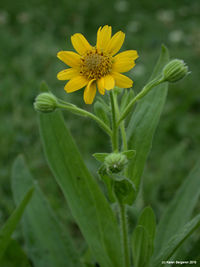Homeopathic Arnica
| See Also | Homeopathic Monographs |
|---|
Arnica is typically the first remedy prescribed for any type of trauma or injury whether physical, mental or emotional. It is used extensively in both acute and chronic states.[1]
Source
- Plant: Arnica montana, also known as Leopard's bane
- Short Form: Arn
Indications
The following are the main indications for Arnica[2], [3]
- Trauma, Injuries, Falls, Sprains and Strains with bruising, bleeding or shock
- Shock whether mental, emotional or physical
- Surgery: used both pre- and post- surgery to promote healing and to decrease bruising, shock and stress to the body
Other common conditions: serious head trauma or concussion, black eyes, nose bleeds, fractures, fright, eye injuries, sciatica, tendinitis and wounds.
Characteristics
- Triggers: trauma or shock or any kind
- General: bruising, bleeding, shock
- Worse: touch, overexertion, injuries
- Better: lying down with the head low
- Psychological: wants to be left alone, insists that nothing is wrong, feels emotionally bruised..
- Other symptoms: weak, sore back, black and blue following an injury, fainting after an accident or traumatic injury, internal and external bleeding.
- Medicinal Actions:
Analgesic, antiecchmotic, anti-inflammatory topically, vulnerary,
Prescribing Considerations
Homeopathic remedies are prescribed based on homeopathic principles and after a detailed case taking. The prescription recommendations below are provided only as a guide. It is always recommended to consult with a naturopathic doctor or homeopathic practitioner prior to taking any homeopathic remedies, especially if your health is compromised or if your symptoms due to resolve in a timely fashion. The general recommendations for Arnica include:[4]
- Arnica is one of the most common acute homeopathic remedies used. It is also used for chronic conditions especially when their onset was triggered by trauma or shock.
- both low and high potencies are used
- for chronic conditions high potencies are typically recommended
- may be applied both topically (locally) and internally
- Complementary remedies: Aconite, Ipec
- Compare: Aconite, Bapt, Bellis, Hamam, Rhus toxicodendron, Hypericum
- Andidoted: by Camphor
References
- ↑ Morrison Roger (1993) Desktop Guide, to Keynote and Confirmatory Symptoms Hahnmann Clinic Publishing
- ↑ Hershoff Asa (2000) Homeopathic Remedies, A Quick and Easy Guide to Common Disorders and their Homeopathic Treatments, Avery Publishing Group, New York.
- ↑ Ullman Robert, Reichenberg-Ullman Judyth (1997) Homeopathic Self-Care, the quick and easy guide for the whole family. Prima Publishing.
- ↑ Boericke W (1996) Pocket Manual of Hemoeopathic Materia Medica and Repertory, a Chapter on Rare and Uncommon Remedies, B. Jain Publishers, India.
